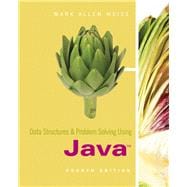
Note: Supplemental materials are not guaranteed with Rental or Used book purchases.
Purchase Benefits
What is included with this book?
PART ONE: TOUR OF JAVA
Chapter 1: Primitive Java
Chapter 2: Reference Types
Chapter 3: Objects and Classes
Chapter 4: Inheritance
PART TWO: ALGORITHMS AND BUILDING BLOCKS
Chapter 5: Algorithm Analysis
Chapter 6: The Collections API
Chapter 7: Recursion
Chapter 8: Sorting Algorithms
Chapter 9: Randomization
PART THREE: APPLICATIONS
Chapter 10: Fun and Games
Chapter 11: Stacks and Compilers
Chapter 12: Utilities
Chapter 13: Simulation
Chapter 14: Graphs and Paths
PART FOUR: IMPLEMENTATIONS
Chapter 15: Inner Classes and Implementation of ArrayList
Chapter 16: Stacks and Queues
Chapter 17: Linked Lists
Chapter 18: Trees
Chapter 19: Binary Search Trees
Chapter 20: Hash Tables
Chapter 21: A Priority Queue: The Binary Heap
PART FIVE: ADVANCED DATA STRUCTURES
Chapter 22: Splay Trees
Chapter 23: Merging Priority Queues
Chapter 24: The Disjoint Set Class
APPENDIX A: Operators
APPENDIX B: Graphical User Interfaces
APPENDIX C: Bitwise Operators
The New copy of this book will include any supplemental materials advertised. Please check the title of the book to determine if it should include any access cards, study guides, lab manuals, CDs, etc.
The Used, Rental and eBook copies of this book are not guaranteed to include any supplemental materials. Typically, only the book itself is included. This is true even if the title states it includes any access cards, study guides, lab manuals, CDs, etc.